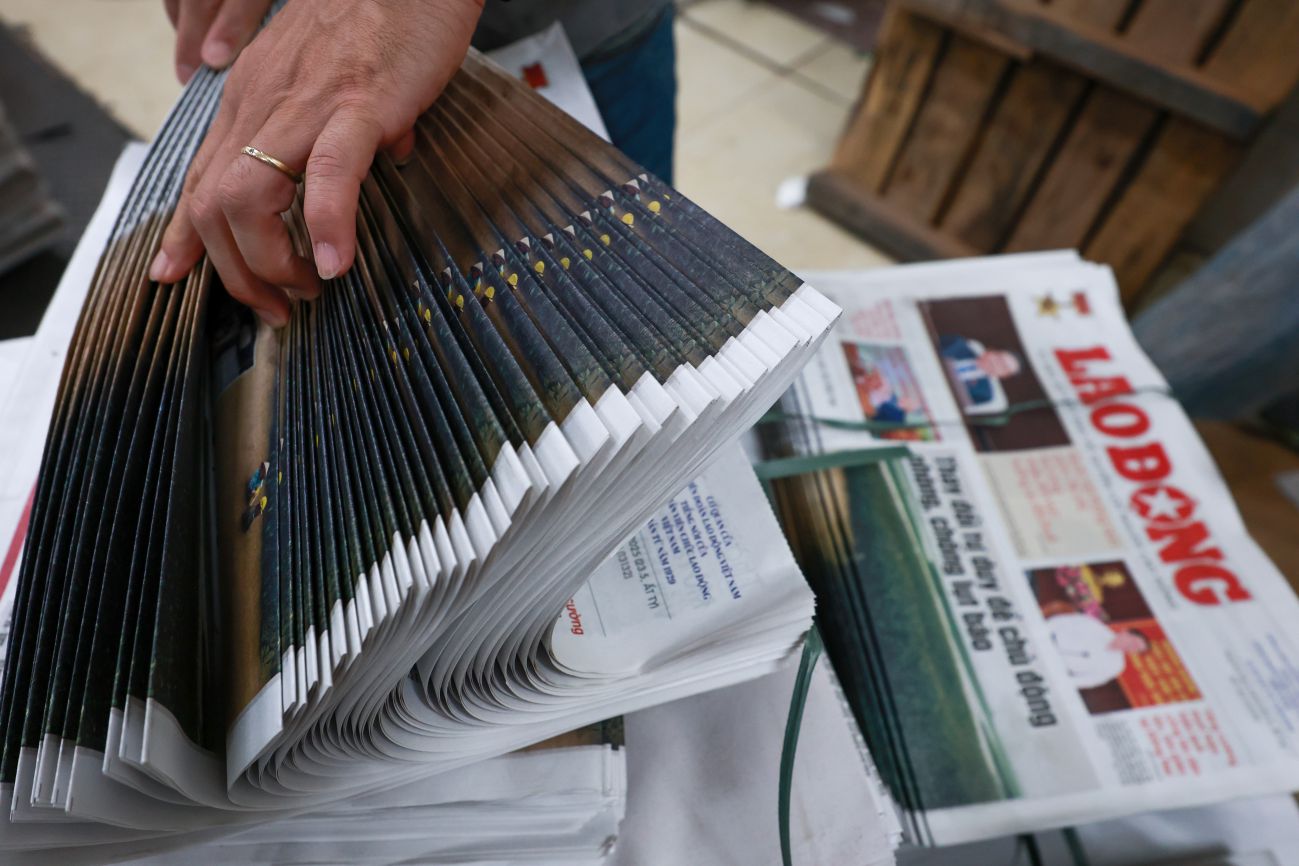Going all over the country all night
Every day, when the city is still sleeping, paper printing workshops start working shifts. Reporters from Lao Dong Newspaper had the opportunity to visit Vietnam Trade Union Printing Joint Stock Company to follow a working shift of workers working in newspaper printing.
The paper newspaper production process starts with receiving the final draft from the newspaper, usually at around 8pm. The pages of the newspapers have been designed and converted into print films through the CTP (Computer to Plate) system, then printed on a aluminum board with a bright coating.
skilled technicians carefully check each color and detail on the printing mold, ensuring that unnecessary parts are cut and displayed well. Then, they put each aluminum mold into a printer, colored it, edited the parameters and started printing thousands of newspapers in a few minutes. The sound of the engine runs regularly throughout the night, the technicians take turns performing the steps of starting the engine, cutting the page to packaging, ensuring progress to meet the night distribution time.

"The smell of printing ink, the smell of printing chemicals, and paper dust has become familiar to me. Working in the pressing profession for more than 25 years, from the days of manual printing, scanning each page to the day with a modern printer, I still rotate with an overnight printing schedule, checking the printing mold", technician Nguyen Thien Ha shared about his long journey with the printing factory of Vietnam Trade Union Printing Joint Stock Company.
During the night, the stations were transferred to trucks, docked at the Post Transport and Supply Company, and continued their journey to distribution points across the country. That is also the time when the working shifts of post office staff become busy. Mr. Chu Quang Cuong, the shifts manager at the shipping warehouse, shared that each shift has about 8 - 9 people, working from evening to 5:00 am, taking turns taking turns taking turns to rest.
After that, thousands of newspapers were gathered at the corner of Dinh Le Street at 4:00 am. Under the street lights, the reporter caught Ms. Nguyen Thi Ly coming as soon as possible, always dividing each newspaper head, watching according to the long-page order list of newspapers. Ms. Ly started working on Dinh Le Street in 2012. From this street corner, the first newspapers of the day will reach news stores and distribution locations across Hanoi.


Time-honored value
In the era of digital technology " expanding", paper newspapers are gradually narrowing. At the newspaper stall No. 11 Phan Huy Chu, the two owners named Ha and Oanh still maintain a yard of about 2m2 to sell paper newspapers every day.
Previously, Ms. Ha's newspaper stall was spacious, not only printing daily issues but also having a variety of weekly newspapers, monthly newspapers, notebooks, magazines... But now, the stall has many newspaper headings but few buyers, many of which are old and fading. Customers coming to buy Ha's newspaper are mostly long-time regulars. Just looking from afar, she recognizes regular customers, knows which newspapers they like to read, and how many leaves they take.

"In the past, this newspaper stall supported my whole family. My grandparents and parents sell newspapers from morning to late at night, and can sell more than 2,000 pieces a day. Since the development of electronic newspapers and social networks, the times have changed. After 35 years, I, a retired young girl, still try to keep the newspaper stall with many generations of the family. From selling thousands of tickets a day, now I sell in the morning, hundreds of tickets a day. Print newspapers have passed their golden age, but many readers still keep the habit of reading morning newspapers. There are many elderly people who stop by every morning, read all the new newspapers in the day and then leave. Those images are still in my memory, for the past 35 years," Ms. Ha confided.

It is undeniable that paper newspapers are facing many challenges. The number of readers is decreasing, the younger generation is used to receiving information via phone and social networks. Production costs are rising while advertising revenue is shifting to digital platforms.
However, it is the small, quiet newspaper stalls at the corner of the street that have contributed to the city's reading culture. The press has gone through a 100-year history, witnessing many changes of the times. Then every dawn, many workers close their shifts, while the paper newspaper begins its own news flow, becoming a quiet joy for many Hanoians.








